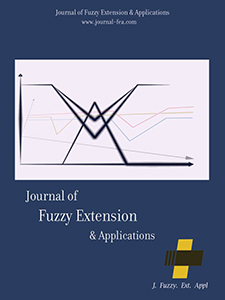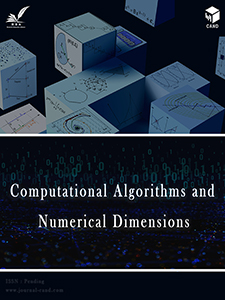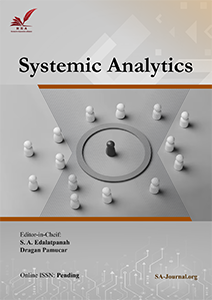Interactive Compromise Programming Approach for Solving Vendor Selection Problems under Fuzziness
Keywords:
Optimization, Multi-objective integer programming, Vendor selection problem, Fuzzy parameters, Triangular fuzzy numbersAbstract
This paper studies a Vendor Selection Problem (VSP) with fuzzy parameters in the price of a unit item, an upper limit of the quantity available, and an aggregate demand for the item. These fuzzy parameters are characterized as fuzzy numbers. An extended efficiency concept called that -efficient solution is introduced using the-level sets of fuzzy numbers. A fuzzy programming approach is applied by defining a membership function after converting the fuzzy VSP into an equivalent deterministic VSP. A linear membership function is being used to obtain optimal compromise solution. An interactive procedure for obtaining -optimal compromise solution is also presented. An illustrative numerical example is given to clarify the obtained results.
References
[1] Wind, Y., & Robinson, P. J. (1968). The determinants of vendor selection: the evaluation function approach. Journal of purchasing, 4(3), 29–42.
[2] Pan, A. C. (1989). Allocation of order quantity among suppliers. Journal of purchasing and materials management, 25(3), 36–39. DOI:10.1111/j.1745-493x.1989.tb00489.x
[3] Bender, P. S., Brown, R. W., Isaac, M. H., & Shapiro, J. F. (1985). Improving purchasing productivity at IBM with a normative decision support system. Interfaces, 15(3), 106–115.
[4] Weber, C. A., & Current, J. R. (1993). A multiobjective approach to vendor selection. European journal of operational research, 68(2), 173–184. DOI:10.1016/0377-2217(93)90301-3
[5] Zadeh, L. A. (1965). Fuzzy sets. Information and control, 8(3), 338–353.
[6] Dubois, D. J., & Prade, H. (1980). Fuzzy sets and systems: theory and applications (Vol. 144). Academic Press.
[7] Tanaka, H., & Asai, K. (1984). Fuzzy linear programming problems with fuzzy numbers. Fuzzy sets and systems, 13(1), 1–10. DOI:10.1016/0165-0114(84)90022-8
[8] Rommelfanger, H., Hanuscheck, R., & Wolf, J. (1989). Linear programming with fuzzy objectives. Fuzzy sets and systems, 29(1), 31–48. DOI:10.1016/0165-0114(89)90134-6
[9] Zhao, R., Govind, R., & Fan, G. (1992). The complete decision set of the generalized symmetrical fuzzy linear programming problem. Fuzzy sets and systems, 51(1), 53–65. DOI:10.1016/0165-0114(92)90075-F
[10] Zimmermann, H. J. (1978). Fuzzy programming and linear programming with several objective functions. Fuzzy sets and systems, 1(1), 45–55. DOI:10.1016/0165-0114(78)90031-3
[11] Sakawa, M., & Yano, H. (1989). Interactive decision making for multiobjective nonlinear programming problems with fuzzy parameters. Fuzzy sets and systems, 29(3), 315–326. DOI:10.1016/0165-0114(89)90043-2
[12] Kumar, M., Vrat, P., & Shankar, R. (2006). A fuzzy programming approach for vendor selection problem in a supply chain. International journal of production economics, 101(2), 273–285. DOI:10.1016/j.ijpe.2005.01.005
[13] Díaz-Madroñero, M., Peidro, D., & Vasant, P. (2010). Fuzzy multi-objective vendor selection problem with modified S-curve membership function. AIP conference proceedings (pp. 278–285). AIP Publishing. DOI:10.1063/1.3459761
[14] Amid, A., Ghodsypour, S. H., & O’Brien, C. (2006). Fuzzy multiobjective linear model for supplier selection in a supply chain. International journal of production economics, 104(2), 394–407.
[15] Kumar, J., & Roy, N. (2010). A hybrid method for vendor selection using neural network. International journal of computer applications, 11(12), 35–40.
[16] Mendoza, A., SantiagoE., & Ravindran, A. R. (2008). A three-phase multicriteria method to the supplier selection problem. International journal of industrial engineering : theory applications and practice, 15(2), 195–210.
[17] He, S., Chaudhry, S. S., Lei, Z., & Baohua, W. (2009). Stochastic vendor selection problem: Chance-constrained model and genetic algorithms. Annals of operations research, 168(1), 169–179. DOI:10.1007/s10479-008-0367-5
[18] Ware, N., Sing, S., & Banwet, D. (2012). Supplier selection problem: A state-of-the-art review. Management science letters, 2(5), 1465–1490.
[19] Ekhtiari, M., & Poursafary, S. (2013). Multiobjective stochastic programming for mixed integer vendor selection problem using artificial bee colony algorithm. ISRN artificial intelligence, 2013, 1–13. DOI:10.1155/2013/795752
[20] Arikan, F. (2015). An interactive solution approach for multiple objective supplier selection problem with fuzzy parameters. Journal of intelligent manufacturing, 26(5), 989–998. DOI:10.1007/s10845-013-0782-6
[21] Lai, Y. J., & Hwang, C. L. (1996). Fuzzy multiple objective decision making. Springer.
[22] Sakawa, M. (1993). Fuzzy sets and interactive multiobjective optimization. Springer.
[23] Alves, M. J., & Clímaco, J. (2007). A review of interactive methods for multiobjective integer and mixed-integer programming. European journal of operational research, 180(1), 99–115. DOI:10.1016/j.ejor.2006.02.033
[24] Khalifa, H. A. (2016). An interactive approach for solving fuzzy multi-objective non-linear programming problems. The journal of fuzzy mathematics, 3(24), 535–545.
[25] Naqvi, M. A., & Amin, S. H. (2021). Supplier selection and order allocation: a literature review. Journal of data, information and management, 3(2), 125–139.
[26] Tronnebati, I., El Yadari, M., & Jawab, F. (2022). A review of green supplier evaluation and selection issues using MCDM, MP and AI models. Sustainability (Switzerland), 14(24), 16714. DOI:10.3390/su142416714
[27] Saputro, T. E., Figueira, G., & Almada-Lobo, B. (2022). A comprehensive framework and literature review of supplier selection under different purchasing strategies. Computers & industrial engineering, 167, 108010.
[28] Moore, R. E. (1979). Methods and applications of interval analysis. SIAM.
[29] Kaufmann, A., & Gupta, M. M. (1988). Fuzzy mathematical models in engineering and management science. Elsevier Science Inc.
[30] Bellman, R, & Zadeh, L. (1970). Decision-making in a fuzzy environment. Management science, 17(4), B--141. DOI:10.1142/9789812819789_0004
[31] Biswal, M. P. (1992). Fuzzy programming technique to solve multi-objective geometric programming problems. Fuzzy sets and systems, 51(1), 67–71. DOI:10.1016/0165-0114(92)90076-G

 Metrics
Metrics


